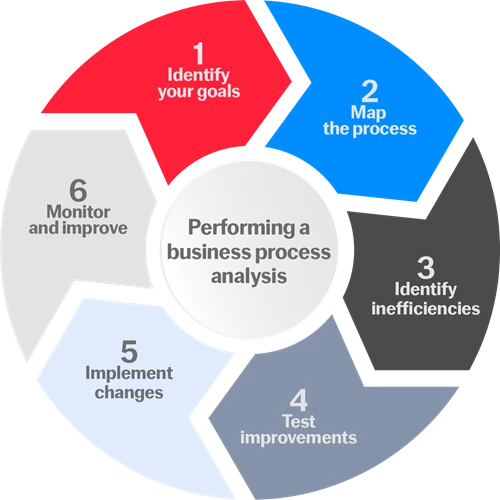
Businesses run on processes, but when workflows are disorganized or overly complex, inefficiencies lead to missed deadlines, higher labor costs, and customer dissatisfaction. Business process analysis helps organizations make improvements to optimize and automate their operations. In this article, we’ll explore what business process analysis is, why it matters, and how it helps organizations work smarter.
Jump to:
What is business process analysis?
Why is business process analysis important?
How business process analysis differs from business analysis
Steps to perform a business process analysis
Business process analysis examples across industries
How ABBYY Process Intelligence enhances business process analysis
What is business process analysis?
Business process analysis is the practice of examining and evaluating business processes to identify inefficiencies, optimize workflows, and improve overall performance.
Typically, business process analysis is performed using specialized tools to help visualize and analyze process data. This gives you a clear view of your “as-is” processes, so you can understand not just how they function, but why. The analysis also allows you to evaluate process performance in detail and develop informed hypotheses for improvement and innovation.
Why is business process analysis important?
Business process analysis gives you insight into how your processes actually function versus how you expect or intend them to. With that knowledge, you can:
- Detect bottlenecks and inefficiencies: By identifying where workflows slow down, resources are underutilized, and unnecessary steps create extra work, you can make informed changes for efficiency.
- Optimize your processes: With clear, data-backed business process analyses, you can better pinpoint areas for improvement and make meaningful changes.
- Increase process automation: Business process analysis creates a pipeline of automation candidates that helps drive productivity improvements, increase revenue, reduce costs, and control risks.
- Improve decision-making: With data-driven insights, you can make smart decisions about process changes and resource allocation that don’t rely on assumptions or guesswork.
- Enhance customer experience: A well-optimized process leads to faster service delivery, better communication, and fewer errors, leading to higher overall customer satisfaction.
- Stay compliant and reduce risks: By analyzing processes in detail, businesses can verify that they are meeting regulatory requirements and industry standards to reduce the risk of compliance violations or fines.
- Reduce costs: Business process analysis equips you with the insights needed to eliminate waste and minimize expenses.
- Adapt quickly and flexibly: Understanding your processes in depth allows for quicker adjustments when business needs change due to new regulations, market shifts, or internal growth.
- Raise employee satisfaction: With streamlined workflows, employees spend less time on redundant tasks and more time on high-value activities. This not only boosts productivity but also improves job satisfaction.
- Improve continuously: Rather than making one-time fixes, business process analysis supports an ongoing cycle of evaluation and improvement.
Business process analysis helps you address immediate inefficiencies and bottlenecks, but it goes further. It takes a broader approach, focusing on building a well-structured, long-term system that continuously adapts to change and delivers lasting value.
How business process analysis differs from business analysis
| Aspect | Business Process Analysis | Business Analysis |
|---|---|---|
| Definition | A process-focused examination of business processes to find opportunities for improvement. | A broader examination of business needs to improve overall performance and strategy. |
| Scope | Explores how processes work, aiming to make them more efficient and effective. | Covers everything related to the business, from market strategy to stakeholder needs. |
| Focus | Focuses on how work gets done to optimize workflows. | Focuses on what the business needs to achieve its goals. |
| Tools | Uses a combination of specialized tools, such as path analysis, to find inefficiencies and outliers, as well as protocol analysis to see that processes are followed correctly. | Uses techniques like SWOT analysis, stakeholder analysis, and business case modeling to guide decision-making. |
| Output/Result | Leads to smoother, more efficient workflows and better process performance. | Delivers strategic recommendations and solutions to business problems. |
Steps to perform a business process analysis

Traditional business process analysis was manual and time-consuming, but today’s advanced tools make it easier to use data from modern (and legacy) core systems to quickly detect slowdowns and uncover performance patterns for improvement. Here are the key steps to performing a business process analysis:
1. Identify your goals and select a process
Start by choosing a well-defined process with clear start and end points, ideally one that is familiar and has a tangible impact on the business. Take the time to clarify what you want to achieve and set clear goals so your analysis leads to actionable improvements.
2. Map the current process
Once you’ve identified the process, the next step is to understand how it actually works. Collect data from process mining and task mining tools, as well as from employees and existing documentation, to provide a comprehensive picture of the current state.
3. Identify inefficiencies and improvement opportunities
With a clear process map in hand, look for bottlenecks, redundancies, and compliance risks that may be slowing things down or creating unnecessary complexity. Identifying these issues early on helps you focus on the changes that will have the biggest impact.
4. Develop and test process improvements
Rather than making sweeping changes all at once, start by testing targeted improvements with pilot tests or simulations. Taking an iterative approach reduces risk and helps ensure that the adjustments truly enhance efficiency.
5. Implement changes to the process
Once you’ve tested and refined your changes, it’s time to put them into action. Roll out the improved process gradually, making sure these changes are practical and sustainable so that they drive real, lasting improvements.
6. Monitor, adapt, and continuously improve
Regularly track key performance indicators (KPIs) to measure success and uncover new opportunities for optimization as business needs evolve. By staying flexible and continuously refining workflows, you can support long-term growth and efficiency. Ongoing monitoring can also support compliance activities and reduce regulatory risks.
Business process analysis examples across industries
With countless business processes across industries, there are endless ways to apply business process analysis. To give you a clearer picture, here are some key examples of how it’s used in different sectors:
- Healthcare: Analyze patient check-in, diagnosis, and treatment workflows to optimize scheduling for faster service and improved patient care.
- Human resources: Simplify employee onboarding by reviewing onboarding steps to remove redundant paperwork and automate processes for new hires.
- Transportation, logistics, and supply chain: Track order processing, inventory management, and shipping routes to minimize delays, reduce costs, and improve delivery efficiency.
- Insurance: Analyze claim verification and approval workflows to reduce processing time and improve customer satisfaction.
- Government and public services: Digitize applications and automate approvals to speed up licensing and permit processing.
How ABBYY Process Intelligence enhances business process analysis

Business process analysis is essential, but true process intelligence goes even further. ABBYY’s AI-powered, five-stage Process Intelligence framework begins with process discovery, mapping out end-to-end workflows as the foundation. Only then does business process analysis take place and provide insights into areas for improvement.
The process doesn’t stop there. After analysis, process monitoring and prediction empower businesses to continuously track performance and address issues before they escalate. Finally, process simulation allows organizations to test process changes and automation scenarios before implementation.
ABBYY Process Intelligence helps businesses not just fix inefficiencies, but also make smarter long-term decisions, test new strategies, and drive continuous improvement. To see what ABBYY Process Intelligence can do for your business, try our 30-day trial.






